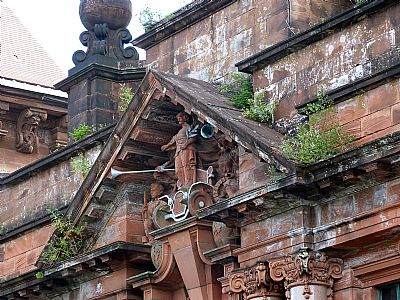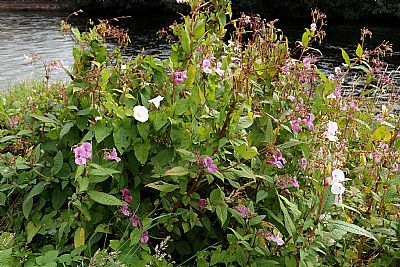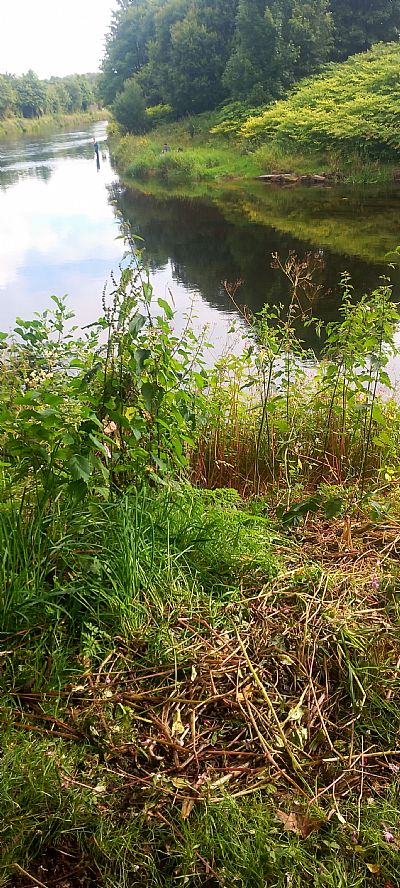INVASIVE SPECIES OF PLANT
Through these pages on plants - flowers, shrubs, trees etc - we have identified several that have been introduced and which have become naturalised. There can be a fine line between invasive and naturalised plants. Or simply confusing.
We happily plant flowers, shrubs and trees in our gardens from around the world, some of which have been specifically bred in nurseries. West Dunbartonshire has some great parks and gardens and is very proud of the historic estates such as Balloch and Overtoun than have amazing collections introduced by collectors on their travels. Having a non-native species is not the problem. The problem is that other plants and the ecosystem itself can be negatively impacted on if some of these get out of hand.

If "weeds" are plants that are in the wrong place, these are prime examples. Plants can do terrible damage if they gain purchase in crevices in buildings. Here we see them all over the front facade of the Argyll Motor Works building ie Lomond Outlets.
While all invasive plants are, by definition, also naturalized plants, not all naturalized plants are invasive plants.
Wiki explains that in botany naturalisation is the situation in which an exogenous plant reproduces and disperses on its own in a new environment.
David Beaulieu writing in The Spruce clarifies it further:
So, to qualify a plant as naturalized, two conditions must be met:
- The plant in question must be foreign ("exotic," "introduced," and "alien" are other names used to tell you that a plant is of foreign origin).
- It must be able to grow on its own and produce a new generation without human aid (for example, without watering, fertilizing, dividing, pest control, or weed control done by human beings). That is, it becomes a wild plant in its adopted homeland. Not all plants introduced from foreign lands are tough enough to naturalize.
- When a plant naturalizes in an area, this can be either a "good" thing or a "bad" thing, depending on your opinion of the particular plant.
A weed is simply a plant that is in the wrong place.
That is a very subjective view. Many plants, the dandelion for instance, are amazing in "natural" environments, but a menace in our otherwise neat gravel at home. And plants that may sting, as nettled do, or poisonous to pets, as daffodils, conjour up very different reactions.
If certain plants have always been here (and that includes any which have been around for many generations) we consider them indigenous. That does not necessarily make them acceptable in all environments, but we generally feel that they belong and even go out of our way to protect them in our wild areas, particularly if these areas are designated nature reserves. We accept that they have specific roles in a balanced ecosystem.
An invasive species is one that is not native that reproduces in a manner that negatively affects native plants and the ecosystem.
By being neagtively affected, we mean that native plants cannot cope with the competition for space or nutrients in the soil and thereby get ousted.
Invasive plants may have root systems that take over an area and deter native species. Or they may affect natural pollinators.
Unwanted and uncontrolled plants may spread through dumping of cuttings or even whole plants in wasteland. Or their seeds may be spread by wildlife including insects. But if there happens to be a watercourse anywhere near, they can be spread at an amazing rate.
Open the sub-tabs to see discussion about some of the invasive species that we find around West Dunbartonshire.
Of particular note are :
BIND WEED : index.asp?pageid=732533
BUDDLEIA : index.asp?pageid=731811
white BUTTERBUR : index.asp?pageid=737871
HIMALAYAN BALSAM : index.asp?pageid=732739
JAPANESE KNOTWEED : index.asp?pageid=732740
- japanese knotweed locations plotted with what3words : index.asp?pageid=737881
MONBRETIA / CROCOSMIA : index.asp?pageid=732982
RHODODENDRON : index.asp?pageid=732298

A very attractive riverside scene. Himalayan Balsam and meadow bindweed in tight embrace. But they are likely to become a threat to other native plants by the way they oust them.

It is July 2024 on the upper Leven towpath. Himalayan Balsam is thriving and some local people have taken it on themselves to attempt to remove it, leaving it in piles to dry out. It is removed quite easily by hand as long as you can reach it on the steep riverbank.
Beyond it though on the other side, Japanese Knotweed is also thriving. It grows much taller. Can you see the two fishermen on the river edge? This plant, a large shrub more than a flower, reaches dramatic height if undisturbed. Where the fishermen stand it is lower. This is because attempts were made years ago to defeat it with herbicide. That had a temporary impact and new growth is coming back with a vengeance.
Himalayan Balsam to some extent allows the growth of other plants in amongst it. Japanese Knotweed simply ousts all in its way.
PLOTTING INVASIVE SPECIES OF PLANTS
West Dunbartonshire Council through its Greenspace department is well aware of invasive species and have a strategy to handle it. WDC is responsible for INNS (Invasive Non-Native Species) management. They have a spraying regime and are in the process of updating the maps. The spraying out normally takes place in September. The public may submit grid references or a what 3 words reference, They can then check if it is on council land and get it added to the list. .
How to plot using ///what3words.
All smart phones can access the what3words app. Download it and open the main page with a map. (Birds eye is usually more useful for this, but a regular map is also available). While out walking up to an invasive species of plant, press the location icon. (It looks like a gun sight). The map will immediately go to your current location. It is not not necessary to go right up to the plant if it is in a dangerous location such as a steep river bank.
The ///what3words app will simultaneously give you 3 words which are specific to that 3 square metres. At the bottom right of your screen is a save tab. That will automatically save that location to favourites. You can find the favourites list by going to the 3 horizontal lines at the top left of your screen.
If you give these 3 words to anyone else with this app they can find the same location almost instantly.
You can find the invasive plants plotted so far here :
GARDENERS WORLD : https://www.gardenersworld.com/plants/rhododendron-ponticum/
THE INDEPENDENT : https://www.independent.co.uk/climate-change/news/rhododendrons-invasive-species-temperate-rainforest-b2108031.html
SCOTTISH INVASIVE SPECIES INITIATIVE : https://www.invasivespecies.scot/index.php/about-us
THE SPRUCE : https://www.thespruce.com/naturalized-plants-flora-of-locale-2131090
WIKIPEDIA : https://en.wikipedia.org/wiki/Naturalisation_(biology)

